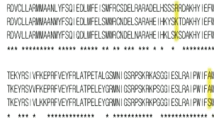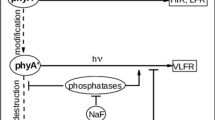Abstract
In the present work, the effect of LiCl on phosphoenolpyruvate carboxylase kinase (PEPCase-k), C4 phosphoenolpyruvate carboxylase (PEPCase: EC 4.1.1.31) and its phosphorylation process has been investigated in illuminated leaf disks and leaves of the C4 plant Sorghum vulgare. Although this salt induced severe damages to older leaves, it did not significantly alter the physiological parameters (photosynthesis, transpiration rate, intercellular CO2 concentration) of young leaves. An immunological approach was used to demonstrate that the PEPCase-k protein accumulated rapidly in illuminated leaf tissues, consistent with the increase in its catalytic activity. In vivo, LiCl was shown to strongly enhance the light effect on PEPCase-k protein content, this process being dependent on protein synthesis. In marked contrast, the salt was found to inhibit the PEPCase-k activity in reconstituted assays and to decrease the C4 PEPCase content and phosphorylation state in LiCl treated plants. Short-term (15 min) LiCl treatment increased IP3 levels, PPCK gene expression, and PEPCase-k accumulation. Extending the treatment (1 h) markedly decreased IP3 and PPCK gene expression, while PEPCase-k activity was kept high. The cytosolic protein synthesis inhibitor cycloheximide (CHX), which blocked the light-dependent up-regulation of the kinase in control plants, was found not to be active on this process in preilluminated, LiCl-treated leaves. This suggested that the salt causes the kinase turnover to be altered, presumably by decreasing degradation of the corresponding polypeptide. Taken together, these results establish PEPCase-k and PEPCase phosphorylation as lithium targets in higher plants and that this salt can provide a means to investigate further the organization and functioning of the cascade controlling the activity of both enzymes.










Similar content being viewed by others
Abbreviations
- CHX:
-
Cycloheximide
- PI-PLC:
-
Phosphoinositide-specific phospholipase C
- IP3 :
-
Inositol 1,4,5-triphosphate
- PEPCase:
-
Phosphoenolpyruvate carboxylase
- PEPCase-k:
-
Phosphoenolpyruvate carboxylase kinase
References
Alvarez R, García-Mauriño S, Feria AB, Vidal J, Echevarría C (2003) A conserved 19-amino acid synthetic peptide from the carboxy terminus of phosphoenolpyruvate carboxylase inhibits the in vitro phosphorylation of the enzyme by the calcium-independent phosphoenolpyruvate carboxylase kinase. Plant Physiol 132:1097–1106
Agetsuma M, Furumoto T, Yanagisawa S, Izui K (2005) The ubiquitin–proteasome pathway is involved in rapid degradation of phosphoenolpyruvate carboxylase kinase for C4 photosynthesis. Plant Cell Physiol 46:389–398
Bakrim N, Brulfert J, Vidal J, Chollet R (2001) Phosphoenolpyruvate carboxylase kinase is controlled by a similar signalling cascade in CAM and C4 plants. Biochim Biophys Res Commun 286:1158–1162
Bakrim N, Nhiri M, Pierre JN, Vidal J (1998) Metabolite control of Sorghum C4 phosphoenolpyruavte carboxylase catalytic activity and phosphorylation state. Photosynthesis Res 58:153–162
Baur B, Dietz KF, Winter K (1992) Regulatory protein phosphorylation of phosphoenolpyruvate carboxylase in the facultative crassulacean-acid metabolism plant Mesembryanthemum crystallinum L. Eur J Biochem 209:95–101
Berridge MJ, Downes CP, Hanley MR (1989) Neural and developmental actions of lithium: a unifying hypothesis. Cell 59:411–420
Black WJ, Van Tol A, Fernando J, Horecker BL (1972) Isolation of a highly active fructose diphosphatase from rabbit muscle: its subunit structure and activation by monovalent cations. Arch Biochem Biophys 151:576–590
Bradford MM (1976) A rapid and sensitive method for the quantification of microgram quantities of protein utilizing the principle of protein-dye binding. Anal Biochem 72:248–254
Borland AM, Hartwell J, Jenkins GI, Wilkins MB, Nimmo HG (1999) Metabolite control overrides circadian regulation of phosphoenolpyruvate carboxylase kinase and CO2 fixation in Crassulacean Acid Metabolism. Plant Physiol 121:889–896
Burnette RN, Gunesekera BM, Gillaspy GE (2003) An Arabidopsis inositol 5-phosphatase gain-of-function alters Abscisic acid signaling. Plant Physiol 132:1011–1019
Coelho SM, Taylor AR, Ryan KP, Sousa-Pinto I, Brown MT, Brownlee C (2002) Spatiotemporal patterning of reactive oxygen production and Ca2+ wave propagation in Fucus rhizoid cells. Plant Cell 14:2369–2381
Coursol S, Giglioli-Guivarc’h N, Vidal J, Pierre JN (2000) An increase in phosphoinositide-specific phospholipase C activity precedes induction of C4 phosphoenolpyruavte carboxylase in illuminated and NH4Cl-treated protoplasts from Digitaria sanguinalis. Plant J 23:497–506
Cushman JC, Meyer G, Michalowski CB, Schmitt JM, Bohnert HJ (1989) Salt stress leads to differential expression of two isogenes of phosphoenolpyruvate carboxylase during crassulacean acid metabolism induction in the common ice plant. Plant Cell 1:715–725
Echevarría C, Vidal J (2003) The unique phosphoenolpyruvate carboxylase kinase. Plant Physiol Biochem 41:541–547
Echevarría C, Vidal J, Jiao JA, Chollet R (1990) Reversible light activation of phosphoenolpyruvate carboxylase protein-serine kinase in maize leaves. FEBS Lett 275:25–28
Echevarría C, Pacquit V, Bakrim N, Osuna L, Delgado B, Arrio-Dupont M, Vidal J (1994) The effect of pH on the covalent and metabolic control of C4 phosphoenolpyruvate carboxylase from Sorghum leaf. Arch Biochem Biophys 315:425–430
Echevarría C, García-Mauriño S, Alvarez R, Soler A, Vidal J (2001) Salt stress increases the Ca2+-independent phosphoenolpyruvate carboxylase kinase activity in Sorghum plants. Planta 214:283–287
Ermolova NV, Cushman MA, Taybi T, Condon SA, Cushman JC, Chollet R (2003) Expression, purification, and initial characterization of a recombinant form of plant PEP-carboxylase kinase from CAM-induced Mesembryanthemum crystallinum with enhanced solubility in Escherichia coli. Protein Expr Purif 29:123–131
Fontaine V, Hartwell J, Jenkins GI, Nimmo HG (2002) Arabidopsis thaliana contains two phosphoenolpyruvate carboxylase kinase genes with different expression patterns. Plant Cell Environ 25:115–122
García-Mauriño S, Monreal JA, Alvarez R, Vidal J, Echevarría C (2003) Characterization of salt stress-enhanced phosphoenolpyruvate carboxylase kinase activity in leaves of Sorghum vulgare: independence from osmotic stress, involvement of ion toxicity and significance of dark phosphorylation. Planta 216:648–655
Giglioli-Guivarc’h N, Pierre JN, Brown S, Chollet R, Vidal J, Gadal P (1996) The light-dependent transduction pathway controlling the regulatory phosphorylation of C4-phosphoenolpyruvate carboxylase in protoplasts from Digitaria sanguinalis. Plant Cell 8:573–586
Gillaspy GE, Gruissem W (2001) Li+ induces hypertrophy and down regulation of myo-inositol monophosphatase in tomato. J Plant Growth Regul 20:78–86
Gillaspy G, Keddle JS, Oda K, Gruissem W (1995) Inositol monophosphatase is a lithium-sensitive enzyme encoded by multigene family. Plant Cell 7:2175–2185
Gil-Mascarell R, López-Coronado JM, Bellés JM, Serrano R, Rodríguez PL (1999) The Arabidopsis HAL2-like gene family includes a novel sodium-sensitive phosphatase. Plant J 17:373–383
Gousset-Dupont A, Lebouteiller B, Monreal J, Echevarria C, Pierre JN, Hodges M, Vidal J (2005) Metabolite and post-translational control of phosphoenolpyruvate carboxylase from leaves and mesophyll cell protoplasts of Arabidopsis thaliana. Plant Sci DOI 10.1016/j.plantsci.2005.07.014
Hartwell J, Smith LH, Wilkins MB, Jenkins GI, Nimmo HG (1996) Higher plant phosphoenolpyruvate carboxylase kinase is regulated at the level of translatable mRNA in response to light or a circadian rhythm. Plant J 10:1071–1078
Hartwell J, Gill A, Nimmo GA, Wilkins MB, Jenkins GI, Nimmo HG (1999) Phosphoenolpyruvate carboxylase kinase is a novel protein kinase regulated at level of expression. Plant J 20:333–342
Hewitt EJ (1966) Sand and water culture methods used in the study of plant nutrition. Commonwealth Bureau of Horticultural and Plantation Crops, East Malling Tech Commun No 22
Inhorn RC, Majerus PW (1987) Effects of lithium on phosphoinositoside metabolism in vivo. J Biol Chem 262:15946–15952
Izui K, Matsumura H, Furumoto T, Kai Y (2004) Phosphoenolpyruvate carboxylase: a new era of structural biology. Annu Rev Plant Biol 55:69–84
Jiao JA, Echevarría C, Vidal J, Chollet R (1991) Protein turnover as a component in the light/dark regulation of phosphoenolpyruvate carboxylase protein-serine kinase activity in C4 plants. Proc Natl Acad Sci USA 88:2712–2715
Kende H (1973) Ethylene biosynthesis. Annu Rev Plant Physiol Plant Mol Biol 44:283–303
Li B, Chollet R (1993) Resolution and identification of C4 phosphoenolpyruvate-carboxylase protein kinase polypeptides and their reversible light activation in maize leaves. Arch Biochem Biophys 307:416–419
Li B, Chollet R (1994) Salt induction and the partial purification/characterization of phosphoenolpyruvate carboxylase protein-serine kinase from an inducible crassulacean-acid-metabolism (CAM) plant, Mesembryanthemum crystallinum L. Arch Biochem Biophys 314:247–254
Li B, Zhang XQ, Chollet R (1996) Phosphoenolpyruvate carboxylase kinase in tobacco leaves is activated by light in a similar but not identical way as in maize. Plant Physiol 111:497–505
Loewus FA, Loewus MW (1983) myo-Inositol: its biosynthesis and metabolism. Annu Rev Plant Physiol 34:137–161
Majerus PW (1992) Inositol phosphate biochemistry. Annu Rev Biochem 61:225–250
Malho R, Moutinho A, Van Der Luit A, Trewavas AJ (1998) Spatial characteristics of calcium signaling: the calcium wave as a basic unit in plant cell calcium signaling. Philos Trans R Soc Lond Ser B 353:1463–1473
Murguia JR, Belles JM, Serrano R (1996) The yeast HAL2 nucleotidase is an in vivo target of salt toxicity. J Biol Chem 271:29029–29033
Nimmo HG (2000) The regulation of phosphoenolpyruvate carboxylase in CAM plants. Trends Plant Sci 5:75–80
Nimmo HG (2003) Control of the phosphorylation of phosphoenolpyruvate carboxylase in higher plants. Arch Biochem Biophys 414:189–196
Nimmo GA, Wilkins MB, Nimmo HG (2001) Partial purification and characterization of a protein inhibitor of phosphoenolpyruvate carboxylase kinase. Planta 213:250–257
Ortega X, Velásquez JC, Pérez LM (2005) IP3 production in the hypersensitive response of lemon seedlings against Alternaria alternata involves active protein tyrosine kinases but not a G-protein. Biol Res 38:89–99
Pacquit V, Giglioli N, Crétin C, Pierre JN, Vidal J, Echevarría C (1995) Regulatory phosphorylation of C4 phosphoenolpyruvate carboxylase from Sorghum: an immunological study using specific anti-phosphorylation site-antibodies. Photosynth Res 43:283–288
Plieth C, Sattelmacher B, Knight MR (2000) Ammonium uptake and cellular alkalisation in roots of Arabidopsis thaliana: the involvement of cytoplasmic calcium. Physiol Plant 110:518–523
Reggiani R, Laoreti P (2000) Evidence for the involvement of Phospholipase C in the anaerobic signal transduction. Plant Cell Physiol 41:1392–1396
Saze H, Ueno Y, Hisabori T, Hayashi H, Izui K (2001) Thioredoxin-mediated reductive activation of a protein kinase for the regulatory phosphorylation of C4-form phosphoenolpyruvate carboxylase from maize. Plant Cell Physiol 42:1295–1302
Smalle J, Vierstra RD (2004) The ubiquitin 26S proteasome proteolytic pathway. Annu Rev Plant Biol 55:555–590
Taybi T, Patil S, Chollet R, Cushman JC (2000) A minimal serine/threonine protein kinase circadianly regulates phosphoenolpyruvate carboxylase activity in Crassulacean Acid Metabolism-induced leaves of the common ice plant. Plant Physiol 123:1471–1482
Tsuchida Y, Furumoto T, Izumida A, Hata S, Izui K (2001) Phosphoenolpyruvate carboxylase kinase involved in C4 photosynthesis in Flaveria trinervia: cDNA cloning and characterization. FEBS Lett 507:318–322
Vidal J, Chollet R (1997) Regulatory phosphorylation of C4 PEP carboxylase. Trends Plant Sci 2:230–237
Wang YH, Chollet R (1993) Partial purification and characterization of phosphoenolpyruvate carboxylase protein-serine kinase from illuminated maize leaves. Arch Biochem Biophys 304:496–502
Zhang F, Phiel CJ, Spece L, Gurvich N, Klein PS (2003) Inhibitory phosphorylation of glycogen synthase kinase-3 (GSK-3) in response to lithium. Evidence for autoregulation of GSK-3. J Biol Chem 278:33067–33077
Acknowledgments
The authors thank R. Chollet for the generous gift of the CAM PEPCase-k antibodies and M. Hodges for carefully reading the manuscript. This research was supported by the Dirección General de Investigación del Ministerio de Ciencia y Tecnología (BMC2001-2366-CO3-02) and by the Junta de Andalucía (PAI group CVI298). José A. Monreal was financed by a FPI fellowship from Universidad de Sevilla (Spain). We thank J.M. Vinardell and J. Ollero for scientific advice and technical support.
Author information
Authors and Affiliations
Corresponding author
Rights and permissions
About this article
Cite this article
Monreal, J.A., López-Baena, F.J., Vidal, J. et al. Effect of LiCl on phosphoenolpyruvate carboxylase kinase and the phosphorylation of phosphoenolpyruvate carboxylase in leaf disks and leaves of Sorghum vulgare . Planta 225, 801–812 (2007). https://doi.org/10.1007/s00425-006-0391-0
Received:
Accepted:
Published:
Issue Date:
DOI: https://doi.org/10.1007/s00425-006-0391-0




